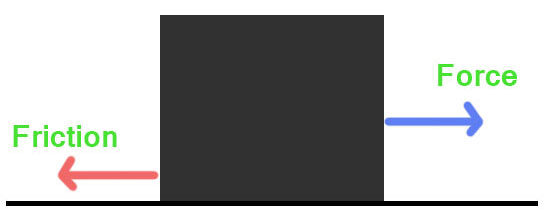 You may be listening to the word friction from your childhood that it slows down the vehicles and wear out the machine part. That is true! Friction causes resistance in motion. It is also a force that acts in opposite direction of motion.
You may be listening to the word friction from your childhood that it slows down the vehicles and wear out the machine part. That is true! Friction causes resistance in motion. It is also a force that acts in opposite direction of motion.
When you put a brake on your bicycle, it stops suddenly because you increase the friction between the wheels and road. It is hard to push a box on a cemented surface than a smooth surface because cemented surface causes more friction due to its irregular surface. On the other hand, if you push the same box on a glass table, it will slide very easily because it has a very smooth surface that causes lower friction.
Types of friction
Friction has been divided into 3 types; static friction, kinetic friction, and fluid friction. All the three types of friction act on any object differently. Let’s see!
Static Friction
 Static friction, as the name suggests occurs between the objects that are in contact with each other but not moving. So, that means if you place a heavy box on a table, will it experience the static friction? No!
Static friction, as the name suggests occurs between the objects that are in contact with each other but not moving. So, that means if you place a heavy box on a table, will it experience the static friction? No!
OK so, when static friction actually occurs? Static friction will only occur between two static objects that are not moving even when the force is applied on them. For example, When you put a box on the table it won’t experience static friction until you apply a force to slide it but it still doesn’t move, then it is experiencing the static friction. But when you push the box even harder, the box will move. Now the static friction will be converted to kinetic friction.
Kinetic Friction
 Now it is time learn about the kinetic friction. Let’s start with an example. Suppose you are riding a bicycle very fast. Tell me what will happen when you suddenly stop paddling? You will notice that the bicycle will start to slow down until it comes to stop completely. This is what you might guess, the kinetic friction!
Now it is time learn about the kinetic friction. Let’s start with an example. Suppose you are riding a bicycle very fast. Tell me what will happen when you suddenly stop paddling? You will notice that the bicycle will start to slow down until it comes to stop completely. This is what you might guess, the kinetic friction!
If one object is moving on another object than both objects will experience kinetic friction. Kinetic friction always occurs between moving objects (In our case, the wheels of bicycles and the road). Normally kinetic friction is less than the static friction due to the motion of the objects.
Kinetic friction is further divided into two types.
- Sliding friction: When two objects slide on each other, both will feel the sliding friction. Pushing a box and rubbing your hands both are the examples of sliding friction.
- Rolling friction: When one object rolls on another object or both are rolling on each other, they will experience rolling friction. It is less than the Sliding friction that is why pushing a weight on wheels is easier than sliding it. The bicycle that you were riding was experiencing rolling friction.

Fluid Friction
 Solids offer two kinds of friction to an object, but there is also another type of friction that is provided by the fluids, e.g. liquids and gases. Let’s see an example to understand the concept more easily.
Solids offer two kinds of friction to an object, but there is also another type of friction that is provided by the fluids, e.g. liquids and gases. Let’s see an example to understand the concept more easily.
What will happen when you drop a coin in oily liquid (your cooking oil)? It will sink slowly to the bottom. Can you tell me why? Yes, you guessed correctly. This is because of the fluid friction. The fluid (oil) is resisting the motion of the coin. Fluid friction increases with two things; one is the velocity of an object and other is viscosity (thickness of liquid) of the fluid. The honey is more viscous than the cooking, so it will provide more friction to the coin. Try it!
The importance of Friction in Everyday Life.
- It helps us to walk on the road. Otherwise, we would skid away.
- You warm your hand by rubbing them together.
- We can stop of vehicles suddenly by putting brakes on them.
- It helps you to hold a pencil or anything tightly. Without friction, the object you hold would easily slip away from your hand.
Why is Friction Avoided?
- Friction cause wears in the machinery parts. So, we lubricate the machines to reduce friction
- Our body joints are well lubricated to reduce friction.
- Reduced fluid friction can increase the mileage of your car. After the speed of 80 km/h, we spend the majority of our fuel to fight friction.







